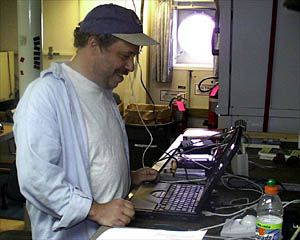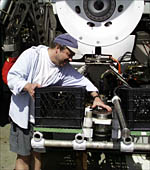Interviews: Dr. Dana Yoerger  Dana works on his laptop computer in the Hydro Lab. He will take it inside Alvin to log data. Question: We’re you always interested in science and engineering as a kid? Where did you go to school and how did you start work at WHOI. Dana: Absolutely! My dad built ships and my older brother is a chemical engineer. My family always encouraged me to pursue my interests in technology. At MIT I had lots of opportunities to work with great professors and students and get good training in mechanical engineering, which was my major. As a student, I focused on robotics and automation and this is still a key area for my research. After I finished my PhD at MIT in 1983, Dr. Robert Ballard who worked at WHOI then, invited me to join the team to develop Jason, one of our early ROV’s. I started work at WHOI in 1984 and I've been a part of WHOI's scientific staff ever since. Helping Ballard’s team to develop ROV Jason, and working with many of the engineers and scientists at WHOI on developments like the ABE autonomous underwater vehicle (AUV) has been a terrific experience.
How did you get to go on this research cruise? Dana: Actually, we've been planning this for almost two years. I was part of a team at DSL that figured out how to use different types of underwater sensors and computers to measure how ROV Jason, ABE (the Autonomous Benthic Explorer), and Alvin move. This type of analysis allows us to make very precise navigation plots of how the vehicles move over the seafloor. When we do our gravity measurements on this cruise, we need take the movement of the vehicle into account since movement creates accelerations, which in turn affect the gravimeter we are using in Alvin. I was invited along by Dan and Jim to help with this part of our experiment. The other goal of my work on this leg is to help the Alvin Group improve the navigation capabilities of the sub. for future users, as well gain experience with these types of sensors that I can apply to my work with the ABE vehicle. Question: What do you expect to discover on this cruise? Dana: We hope to demonstrate that we can take continuous (one every second) gravity measurement as Alvin traverses the seafloor at an altitude of about 7 meters (23 feet). If this works like we think it will, then we’ll have a new way to observe the shallow structure of the ocean crust at the mid-ocean ridge crest and understand in more detail how sea floor spreading occurs and how lava flows build the ocean crust. Question: How often do you go to sea? Do you like it? Dana: I go to sea about three times each year, and spend from two weeks to two months at a time on board a ship doing research. Over the years, I’ve been able to visit many foreign ports and sail in most oceans of the world. Last year I was invited to join a cruise to the southern East Pacific Rise that started in Easter Island. That was a fantastic experience. Question: What do you do with the data you collect back in the lab at Woods Hole? Dana: Most of my time in the lab is used to make scientific and engineering sense of the data we gather at sea. I reviewand analyze our results to determine ways to improve the deep submergence vehicles operated by WHOI, and figure out ways to make our measurements better. Also, I develop ways to make the techniques used on one type of deep submergence vehicle, like Alvin for instance, work on other vehicles such as the ABE autonomous underwater vehicle (AUV) or ROVs so that they work better and more efficiently for science and engineering applications. I also spend lots of time workingon proposals for future technology developments and research cruises. Question: When you're not working, how do you have fun? Dana: My wife and I have four children and two grandchildren and I enjuoy spending time with them. I also really enjoy fishing and like to garden. Question: What is the best part and the worst part of what you do? Dana: I love it when we are successful in devloping a new technology that allows scientists to see the world in a different way; this usually leads to new discoveries. I think one of the hardest and most frustrating things I have to deal with is to work really hard on a research proposal and then be rejected by a funding agency. That’s almost as bad as getting seasick! But I’ve learned that I have to just stick to it and make it better next time. If it’s a good idea it will happen.
|
||||
© 2010 Dive and Discover™. Dive and Discover™ is a registered trademark of
Woods
Hole Oceanographic Institution

